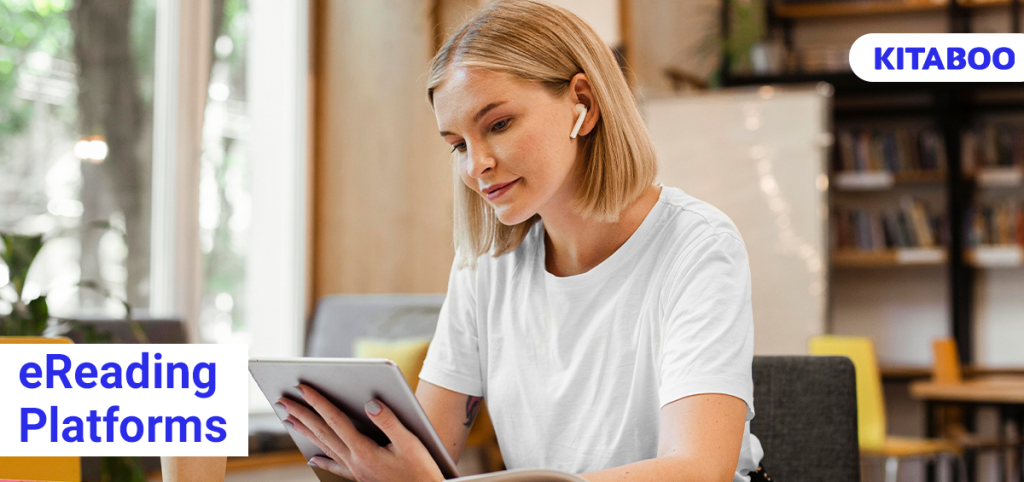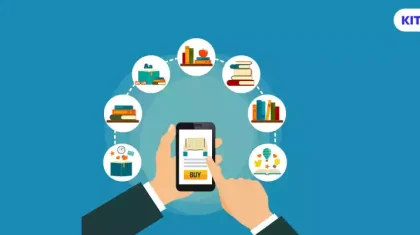
Comparing Top 5 eReading Platforms for K12 Learning
Summarize this blog with your favorite AI:
eReading platforms today offer bookworms a convenient and portable way to indulge in their favorite pastime. However, with numerous platforms available, it can be challenging to determine which one best suits your K12 learners’ reading preferences.
In this blog, we will compare the top five eReading platforms on the basis of their features, functionalities, and overall reading experience.
So, let’s dive into the world of digital reading and learning to find the perfect platform for your students’ literary adventures.
Table of Contents
- Top Five eReading Platforms for K12 Learning
Top Five eReading Platforms for K12 Learning
1. KITABOO
Topping our list is KITABOO, an all-inclusive eReading platform that caters specifically to the educational sector.
Its user-friendly interface and extensive feature set make it a standout choice. Supporting multiple formats such as PDF, ePub, and HTML5, KITABOO allows seamless content access across various devices.
The platform provides a delightful reading experience for learners with its customizable fonts and adjustable font sizes. Interactive features such as annotations, highlighting, and bookmarking enable students to engage with the content and make personal notes.
KITABOO also supports both online and offline reading, ensuring students can access their eBooks anytime, anywhere. Additional features like search functionality, dictionary integration, and social sharing enhance the overall reading experience.
2. Kindle
Developed by Amazon, Kindle has established itself as a prominent player in the eReading landscape.
Kindle offers an extensive library of eBooks and seamless integration with Amazon’s Kindle Store. With a range of Kindle devices including eInk readers and tablets, Kindle provides a dedicated reading experience.
It offers adjustable fonts, highlighting, note-taking, and dictionary integration for an enhanced reading experience. Kindle also supports synchronization across devices, allowing students to seamlessly switch between Kindle devices and the Kindle app on smartphones or tablets.
Additional features like Whispersync, which syncs reading progress across devices, and Kindle Unlimited, a subscription service granting access to a vast collection of eBooks, make Kindle a compelling choice in the K12 learning landscape.
3. Nook
Barnes & Noble’s Nook platform is another notable contender, offering a wide range of eBooks and digital content. Nook provides both eReaders and a mobile app for access to content across various devices.
The platform also allows students to personalize their reading settings with adjustable fonts, font sizes, and background colors. Interactive features such as highlighting, note-taking, and dictionary integration contribute to a pleasant reading experience.
Nook’s extensive library comprises additional resources for students such as eBooks, newspapers, and magazines, which can be accessed through the Nook Store.
4. Kobo
Renowned for its eInk readers and mobile apps, Kobo presents an enticing eReading platform. Kobo offers a diverse selection of eBooks, including bestsellers and indie titles. The platform allows users to fine-tune their reading experience with adjustable fonts, font sizes, and night mode. It also provides annotation tools, highlighting, and dictionary integration for an engaging reading session. Kobo’s Reading Life feature offers reading statistics and achievements, enhancing user engagement.
5. Google Play Books
Last but not least, Google Play Books boasts a vast collection of eBooks, ranging from bestsellers to free classics and self-published works. With its Google Play Books app, the platform ensures compatibility across devices.
Users can customize their reading experience by adjusting fonts, font sizes, and utilizing night mode. The platform offers interactive features such as highlighting, note-taking, and dictionary integration. Cloud synchronization enables seamless access to books across devices.
Conclusion
With regard to K12 learning, it is clear that KITABOO stands tall as the ultimate eReading platform, offering a comprehensive range of features and a user-friendly interface. With its vast library, customizable reading options, and interactive tools, KITABOO provides students with an unparalleled learning experience.
To truly experience the power of KITABOO, we invite you to set up a demo and explore its remarkable features firsthand.
Discover the joy of digital reading with KITABOO and help your students embark on a journey that transcends the boundaries of traditional books.
Frequently Asked Questions
- Q: What makes KITABOO the number one eReading platform for K12 learners?
A: KITABOO is a digital-textbook platform. That apart it excels as an eReading platform due to its user-friendly interface, extensive features, and support for various formats. KITABOO also provides interactive features like annotations, highlighting, and bookmarking, enhancing the overall reading experience.
- Q: How does KITABOO compare to other popular eReading platforms like Kindle and Nook?
A: KITABOO stands out with its comprehensive feature set, offline reading support, wide range of supported formats and its focus on educational content. While Kindle offers seamless integration with the Amazon ecosystem and Nook provides personalization options, KITABOO offers a unique blend of features that cater to the needs of the K12 or any other learner.
- Q: Can I access my KITABOO eBooks across different devices?
A: Yes, KITABOO allows seamless access to eBooks across various devices. It supports synchronization, ensuring that your reading progress, annotations, and bookmarks are available on multiple devices. Whether you prefer reading on a tablet, smartphone, or computer, KITABOO provides a consistent reading experience.
- Q: Does KITABOO offer additional features beyond reading eBooks?
A: Yes, KITABOO offers more than just an eBook reader. It provides features like search functionality, dictionary integration, and social sharing. These features enhance the overall reading experience and allow students to engage with the content in more meaningful ways.
- Q: How can I experience KITABOO for myself?
A: To experience the power of KITABOO, you can set up a demo. This will give you firsthand access to explore the platform’s remarkable features and functionalities. By trying out the demo, you can fully appreciate the immersive reading experience that KITABOO offers.
Discover how a mobile-first training platform can help your organization.
KITABOO is a cloud-based platform to create, deliver & track mobile-first interactive training content.


